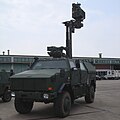German Army
| German Army Deutsches Heer | |
|---|---|
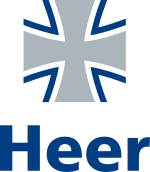 Logo of the German Army | |
| Active | 1955–present |
| Country | Federal Republic of Germany |
| Role | Land force |
| Size | 103.950 [1] |
| Motto(s) | To protect, help, moderate, and fight Schützen, helfen, vermitteln, kämpfen |
| Colors | Blue, Grey and White |
| Anniversaries | November 12, 1955 |
| Engagements | United Nations Operations in Somalia Aftermath of the Balkan Wars 1995-1999 Kosovo War War in Afghanistan |
| Decorations | Badge of Honour of the Bundeswehr Military Proficiency Badge Badge of Marksmanship Service Medal Flood Service Medal |
| Commanders | |
| Current commander | Lieutenant General Hans-Otto Budde |
| Notable commanders | General Ulrich de Maizière General Ernst Ferber, COMAFCENT 1973–1975 Lieutenant General Jörg Schönbohm, later Undersecretary of Defense |
The German Army (Template:Lang-de, Heer pronounced [ˈheːɐ̯] ) is the land component of the armed forces of the Federal Republic of Germany. Traditionally the German military forces have been composed of Army, the Navy, and an Air Force after World War I. It was reinstalled in 1955 as the West German Army and as a part of the newly formed Bundeswehr. In the aftermath of the German reunification of 1990, the National People's Army of the former German Democratic Republic was integrated into the West German Army.
History
Overview

Since Germany first became a modern unified state in 1871, previous names of German unified ground forces have included:
- 1871–1919 Kaiserlich Deutsches Heer or Imperial German Army, part of Imperial Forces (Reichsheer was also used)
- 1921-1935 Reichsheer or National[2] Army, part of the Reichswehr
- 1935–1945 Heer or Army, part of the Wehrmacht
- 1956–1990 Landstreitkräfte, ground forces of East German Nationale Volksarmee
- 1955–present Deutsches Heer or German Army, part of the Bundeswehr
Pre-1914
After the reform movement of the Prussian Army following a series of disastrous defeats at the hands of her enemies in the 18th Century, internal analysis of the lessons learned had informed Prussian civilian and military leadership that, while individual soldiers were first rate, command structures, staff organization and generalship was a hit-and-miss affair, more dependent on the martial skills of the King and the individual members of the German nobility who dominated the military profession. Too often, military talent was brought together only after the Nation faced a crisis. There was little effective organizational work in between wars. The rise of the German General Staff, an institution that sought to institutionalize military excellence, brought the German Army back from years of atrophy and the humiliation of Napoleon's capture of Berlin. With a membership in the officer corps extended to all qualified German speaking men via national examinations, the improved education of the military schools, the intensive selection process of the top 1% graduated from the Kriegsacademie, with its new rising class of top notch and world class leaders, the German Army was set on a course of eventual near total dominance in Europe.
Following the defeat of Napoleon at the Battle of Waterloo the Prussian Kingdom had years of military successes in the 19th and 20th centuries. Every able bodied man between the ages of 17 and 45 was liable for military service. There were 4 classes of service - Active (Aktiv), Reserve, Landwehr and Landsturm. The Landwehr and Landsturm were only called up at times of war. The basic unit of the army at this time was the Regiment. Regiments were typically raised and supported by a specific city or region. Each regiment was then stationed near its home city. The Reserve regiment was often made up of past members of the local regiment. The Landwehr and Landsturm units were also organized the same way. An individual could spend all 22 years of military service surrounded by their friends and family. While this system created close ties within regiments, it also meant that the entire population of young men from a city or region could be wiped out in one battle.
World War I 1914–1918
The German army that fought in World War I was not in fact a single, unitary army. All the monarchies (Great Dukedom of Hesse, Great Dukedom of Baden - as example) as a part of the German empire had its own armies. Since the unification of Germany in January 1871 most of them were under Prussian command, though each continued to wear its own style of uniforms and insignias. The four German kingdoms that existed since the Napoleonic era - Bavaria, Prussia, Saxony and Württemberg - of course had its own armies until the end of WW I. The commander in chief in peacetime of each of these armies was the King. Prussia had the largest army of the four. After the unification and the formation of the German Empire, the Prussian army became the nucleus of the Armies of the German Empire (Deutsches Reichsheer). After the declaration of war, the emperor became the commander-in-chief of all the armed forces. By 1914 the German army fielded 50 active divisions and 48 Reserve-Divisions - by 1918 251 divisions had been created.
Reichswehr 1918–1935
Following the end of World War I and the collapse of the German Empire, most of the German Army (Heer) was demobilised or simply dissolved. Many former soldiers drifted into small paramilitary groups known as Free Corps (Freikorps). The Free Corps were generally groups of 100 men or fewer that protected a neighborhood or town.
On 6 March 1919 an army known as the Provisional German Defence Force (Vorläufige Reichswehr) was formed with about 400,000 men, many drawn from the Free Corps. Then, on 30 September 1919 the Transitional Army (Übergangsheer) was created from the Defence Force and the Free Corps.
Finally, on 1 January 1921 the 100,000 man Army of the Weimar Republic (Reichswehr) was formed with seven Infantry Divisions and three Cavalry Divisions. In November 1923, it was troops from the Army of the Weimar Republic who crushed Adolf Hitler's Beer Hall Putsch in Munich.
Wehrmacht 1935–1945
Under the Treaty of Versailles, the Reichswehr was only allowed 100,000 men split between the Army and the Navy. Following the 1932 German elections the Nazi party came to power and began to abrogate the treaty. The Army was made part of the Wehrmacht in May 1935 with the passing of the "Law for the Reconstruction of the National Defence Forces". The Wehrmacht included not just the Army and Navy but also a third branch known as the Luftwaffe. Initially, the Army was expanded to 21 divisional-sized units and smaller formations. Between 1935 and 1945 this force grew to consist of hundreds of divisions and thousands of smaller supporting units. Between 1939 and 1945 close to 16 million served in the Army. Over 3 million were killed and over 4.1 million were wounded. Of the 7,361 men awarded the initial grade of the highest German combat honour of World War II, the Knight's Cross of the Iron Cross, 4,777 were from the Army, making up 65% of the total awarded. The Allies dissolved the German Army on 20 August 1946.
Cold War and the 1990s
- see also: Tank formations during the Cold War
The Heer was founded in 1955 as the army of West Germany. After 1990, it absorbed the army of socialist East Germany, a part of the Nationale Volksarmee. The former East German forces were initially commanded by the Bunderwehr Command East under command of Lieutenant General Jörg Schönbohm, which was disbanded on 30 June 1991.[3] In the aftermath of the merge, the German Army consisted of four Corps with a manpower of 360,000 men. It was continuously downsized from this point. In 1996, an airborne brigade was converted into a new command leading the Army's special forces, known as the Kommando Spezialkräfte.
The 2001 onwards restructuring of the German Army saw it move to a seven division structure – 5 mechanised (each with two mechanised brigades), 1 special forces, and one airmobile.
In 2003, three Corps still existed, each including various combat formations and a maintenance brigade. I. German/Dutch Corps, a joint German-Netherlands organisation, used to control in peacetime the 1st Panzer and 7th Panzer Divisions as well as Dutch formations. The 1st Panzer would have reported to the corps in wartime while the 7th would be posted to the Allied Rapid Reaction Corps. II Corps was German in peacetime but would have exchanged a division with the V U.S. Corps in time of war (the 5th Panzer). 5 Pz Division disbanded as of 30 June 2001. In peacetime it also commanded the 10th Panzer Division, which was allocated to Eurocorps and which parents the German half of the Franco-German Brigade. The 1st Mountain Division at Munich was also under this headquarters.
The IV Corps was headquartered at Potsdam in eastern Germany and controlled two Panzer-Grenadier Divisions, the 13th and 14th. The 14th Panzer-Grenadier Division also took control of units in Western Germany re-subordinated from the 6th Division when it lost its command function. It would have made up the German contribution to the Multinational Corps Northeast in time of war. IV Corps also used to have under its command the Military District Command I, the 1st Air Mechanised Brigade, and the Berlin Command ('Standortkommando').
Current Army
| Bundeswehr |
|---|
| Branches |
| Organisational areas |
|
Joint Medical Service Joint Support Service |
All corps have now been disbanded or transferred to a multinational level such as Multinational Corps North East. IV. Corps was reorganized and became an overseas deployment command like the British Permanent Joint Headquarters.
Personnel
A total of 103,950 soldiers are currently on active service in the German Army.[4] Of these, approximately 17,000 are draftees. Additionally, a further 35,000 personnel of reservists of the German Army reserve force are available.
Current structure of the German Army

The German Army is commanded by the Chief of Staff, Army (Inspekteur des Heeres) based at the Federal Ministry of Defence in Berlin and Bonn. The major commands are the German Army Office in Cologne and the German Army Forces Command in Koblenz. In 2002 a number of army units and their personnel were transferred to the newly-formed Joint Support Service (Streitkräftebasis) and Joint Medical Service branches.[5]
Chief of Staff, German Army
- Lieutenant General Hans-Otto Budde
- Army Staff at the Federal Ministry of Defence
German Army Office

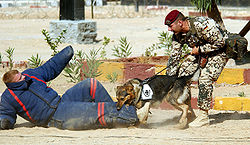
The German Army Office in Cologne (Heeresamt) is the superior authority for all supporting elements of the Army, such as schools and education centres. It is commanded by a Major General, currently MajGen Joachim Clauß.
- NBC Defence and Self-Protection School in Sonthofen
- Military Police and Headquarters Services School in Sonthofen
- Artillery School in Idar-Oberstein
- Three Officer Candidate Battalions in Idar-Oberstein, Munster and Hammelburg
- Special Operations Training Centre (formerly International Long Range Reconnaissance Patrol School) in Pfullendorf
- Army Warfighting Simulation Centre in Wildflecken
- Army Combat Training Centre in Letzlingen
- Army Aviation School in Bückeburg
- Training Centre Munster for
- Army Air Defence
- Armour
- Reconnaissance
- Mountain and Winter Combat School in Mittenwald
- Infantry School in Hammelburg
- Airborne Operations and Air Transport School in Altenstadt
- Army Officers' Academy in Dresden with Army Tactics Centre
- Army NCO Academies (three at different locations)
- Engineer School and Army School of Structural Engineering in Ingolstadt (formerly in Munich)
- Army Maintenance School and Army School of Engineering in Aachen
German Army Forces Command


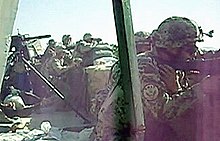

The German Army Forces Command in Koblenz (Heeresführungskommando) exercises command and control over all combat units. It is commanded by a Lieutenant General. These units include two armour divisions, two mechanized infantry divisions, the Division for Specialized Operations and the Airmobile Division. Depending on their size and role, brigades can be commanded either by a Brigadier General alike or a Colonel. Unlike other European armies such of neighbouring Netherlands and France, regiments are not a common form of organization and are thus rare in the German army. Battalions are most likely directly subordinate to brigades or to divisions as divisional troops.
 Division Intervention Forces/ 1st Armoured Division (Hannover)
Division Intervention Forces/ 1st Armoured Division (Hannover)
- Divisional troops
- 9th Armoured Brigade
- 21st Armoured Brigade "Lipperland"
 13th Mechanized Infantry Division (Leipzig)
13th Mechanized Infantry Division (Leipzig)
- Divisional troops
- 37th Mechanized Infantry Brigade "Freistaat Sachsen"
- 41st Mechanized Infantry Brigade "Vorpommern"
 Special Operations Division (Regensburg)
Special Operations Division (Regensburg)
- Divisional troops
- Special Forces Command (brigade-equivalent)
- 26th Airborne Brigade "Saarland"
- 31st Airborne Brigade "Oldenburg"
 Airmobile Operations Division (Veitshöchheim)
Airmobile Operations Division (Veitshöchheim)
- Divisional troops
- Airmobile Brigade 1
- Army Combat Support Brigade
- Eurocorps (Straßburg)
- Command Support Brigade
- German elements in two permanent battalions and one staff company
 1 (German/Netherlands) Corps (Münster)
1 (German/Netherlands) Corps (Münster)
- German elements in two permanent battalions and one staff company
 Multinational Corps North East (Stettin)
Multinational Corps North East (Stettin)
- 610th Signal Battalion
- German elements
 Army Central Dump Herongen
Army Central Dump Herongen
 Army Central Dump Pirmasens
Army Central Dump Pirmasens
 Central Mobilisation Base in Brück
Central Mobilisation Base in Brück
Truppengattungen

The German Army has eleven different branches of troops, designated as Truppengattungen. Each Truppengattung is responsible for training and readiness of its units and disposes of its own schools and centres of excellence for doing so. Optically this distinction can be made by the branch colour, called Waffenfarbe which is displayed by a cord attached to the rank insignia, and the colour of their beret with a specific badge attached to it.
Beret Colour (Army only)
- Black: Armoured Corps, Reconnaissance Corps
- Green: Mechanized Infantry and Rifles Corps
- Dark Red: Aviation Corps, Airborne Corps, Special Forces, formations assigned to airborne division
- Light Red: Combat Support Corps and Military Police
- Dark Blue: Medical Corps
- Navy Blue: Multinational Units, Officer Cadet Battalions, Navy and Air Force Security Units
- Bright Blue: Troops with United Nations Missions
Waffenfarbe (Army and army support branch only)
-
Military Police/
Signal/
Army Air Defence/
Army Air Corps -
NBC/
Artillery/
Army Reconnaissance -
Infantry as Airborne, Mountain Infantry, Light Infantry (Rifles), Mechanized Infantry/
Armoured Troops/
Engineers -
Army Bands/
Supplies, Maintenance an Transportation Troops/
Medical Corps
- Bright Red:General ranks (only "Kragenspiegel", not "Litze"),
- Crimson: General Staff
Rank structure
The rank structure of the German army is adjusted to the rank structure of the NATO. Unlike its predecessors, the modern German Army does not use the rank of Colonel General.
The highest rank for an army officer is Lieutenant General, as the rank of Full General is reserved for the Armed Forces chief of staff or officers serving as NATO officers.
Officer cadets do not pass through all enlisted ranks, but are directly promoted to Lieutenant after 36 months of service.
Equivalent US Army ranks are shown below according to "STANAG 2116 NSA MC LO (EDITION 6) – NATO CODES FOR GRADES OF MILITARY PERSONNEL":
| Officers of the German Army | ||||||||||
|---|---|---|---|---|---|---|---|---|---|---|
| General (General) Gen |
Lieutenant General (Generalleutnant) GenLt/GL |
Major General (Generalmajor) GenMaj/GM |
Brigadier General (Brigadegeneral) BrigGen/BG |
Colonel (Oberst) Oberst/O |
Lieutenant Colonel (Oberstleutnant) Oberstlt/OTL | |||||
| OF-9 | OF-8 | OF-7 | OF-6 | OF-5 | OF-4 | |||||

|

|

|

|

|

| |||||
| Officers of the German Army | ||||||||||
|---|---|---|---|---|---|---|---|---|---|---|
| Major (Major) Maj/M |
Staff Captain (Stabshauptmann) StHptm/SH |
Captain (Hauptmann) Hptm/H |
1st Lieutenant (Oberleutnant) OLt /OL |
2nd Lieutenant (Leutnant) Lt/L | ||||||
| OF-3 | OF-2 | OF-2 | OF-1 | OF-1 | ||||||

|

|

|

|

| ||||||
| Non-Commissioned Officers of the German Army | ||||||||||
|---|---|---|---|---|---|---|---|---|---|---|
| Sergeant Major (Oberstabsfeldwebel) OStFw/OSF |
First Sergeant (Stabsfeldwebel) StFw/SF |
Master Sergeant (officer cadet) (Oberfähnrich) OFähnr/OFR |
Master Sergeant (Hauptfeldwebel) HptFw/HF |
Sergeant 1st Class (Oberfeldwebel) OFw/OF | ||||||
| OR-9 | OR-8 | OR-8 | OR-7 | OR-6 | ||||||

|

|

|

|

| ||||||
| Non-Commissioned Officers of the German Army | ||||||||||
|---|---|---|---|---|---|---|---|---|---|---|
| Sergeant (officer cadet) (Fähnrich) Fähnr/FR |
Sergeant (Feldwebel) Fw/F |
Staff Corporal (Stabsunteroffizier) StUffz/SU |
Corporal (officer cadet) (Fahnenjunker) Fhj/FJ |
Corporal (Unteroffizier) Uffz/U | ||||||
| OR-6 | OR-6 | OR-5 | OR-5 | OR-5 | ||||||

|

|

|

|

| ||||||
| Enlisted Ranks of the German Army | ||||||||||
|---|---|---|---|---|---|---|---|---|---|---|
| Lance Corporal (Oberstabsgefreiter) OStGefr/OSG |
Lance Corporal (Stabsgefreiter) StGefr/SG |
Lance Corporal (Hauptgefreiter) HptGefr/HG |
Private 1st Class (NCO cadet) (Obergefreiter UA) OGefr/OG |
Private 1st Class (Obergefreiter) OGefr/OG | ||||||
| OR-4 | OR-4 | OR-3 | OR-3 | OR-3 | ||||||

|

|

|

|

| ||||||
| Enlisted Ranks of the German Army | ||||||||||
|---|---|---|---|---|---|---|---|---|---|---|
| Private 1st Class (officer cadet) (Gefreiter OA) Gefr/G |
Private 1st Class (Sergeant cadet) (Gefreiter FA) Gefr/G |
Private 1st Class (NCO cadet) (Gefreiter UA) Gefr/G |
Private 1st Class (Gefreiter) Gefr/G |
Private (Soldat) S | ||||||
| OR-2 | OR-2 | OR-2 | OR-2 | OR-1 | ||||||

|

|

|

|

| ||||||
Weapons
Standard light weapons
- Heckler & Koch G36—5.56 mm x 45 assault rifle (Version G36K and G36C for several branches including Special Forces)
- Heckler & Koch MG4—5.56 mm light machine gun
- MG3—7.62 mm x 51 machine gun
- G8—7.62 mm x 51 automatic rifle, only used by special forces
- HK21E—7.62 mm x 51 machine gun, only used by special forces
- Heckler & Koch MP7—4.6 mm x 30 submachine gun, replacing the MP2
- MP2—9 x 19 mm submachine gun
- Heckler & Koch MP5—9 x 19 mm submachine gun, used by various units like the Feldjäger and special forces
- Heckler & Koch P8—9 x 19 mm pistol
- Remington 870 - shotgun, used in small numbers by special forces and the military police (Feldjäger)
- G22—7.62 mm x 66.5B sniper rifle
- G24—sniper rifle, only used by special forces
- G82—sniper rifle
- HK MSG3—7.62 mm x 51 designated marksman rifle
- Dynamit Nobel Panzerfaust 3—anti-tank rocket launcher
- Raytheon Fliegerfaust 2 (FIM-92 Stinger)—infrared homing surface-to-air missile
- MILAN—anti-tank guided missile system
- Granatpistole 40mm—grenade launcher
- HK GMG—grenade autocannon
- AG36—grenade launcher
- KM2000—172 mm tantō style blade standard combat knife
Reconnaissance systems
- Fennek (wheeled armoured reconnaissance vehicle), replacing the Spähpanzer Luchs
- Luna X 2000 (reconnaissance drone system)
- KZO (reconnaissance drone system)
- Aladin (reconnaissance drone system)
- Camcopter S-100 (VTOL reconnaissance drone system, procurement planned)[6]
- MIKADO (mini reconnaissance drone system)
- Fancopter (mini reconnaissance drone system)
- RASIT (radar system), being phased out
- BÜR (ground surveillance radar system, based on Dingo 2)
-
Luna X 2000 UAV
-
EMT Aladin UAV
-
MIKADO
-
Fancopter
-
BÜR
Combat vehicles
Statistics



- Leopard 2 (Main Battle Tank)
- A4, being phased out
- A5
- A6
- Marder 1 A3/A5 (infantry fighting vehicle)
- Spz Puma (infantry fighting vehicle), replaces the Marder in the Mechanized Infantry, being delivered
- Wiesel 1/2 (armoured weapons carrier),
- as a reconnaissance vehicle for the airborne troops
- with autocannon 20 mm
- with TOW anti-tank guided missile
- with mortar 120 mm
- as a radar vehicle for the light air defence system (LeFlaSys)
- as a command vehicle for the LeFlaSys
- as an engineer reconnaissance vehicle
- with Stinger equipped for the LeFlaSys
- as a medical vehicle for the airborne troops
- IAI Harop (unmanned combat aerial vehicle), loitering munition in combination with Rheinmetall KZO, ordered
- M113 A2 (multirole armoured vehicle) being phased out
- GTK Boxer (multirole armoured fighting vehicle) to replace M113 and TPz Fuchs (planned)
- Dingo 1/2 (armoured wheeled vehicle)
- Eagle IV (armoured wheeled vehicle)
- LAPV Enok (light armoured patrol vehicle)
- Grizzly (armoured wheeled vehicle)
- AGF Serval (reconnaissance and combat vehicle)
- DURO III (armoured wheeled vehicle)
- YAK (armoured wheeled vehicle), based on DURO III
- Mungo ESK (armoured transport vehicle)
- TPz Fuchs (multirole armoured vehicle)
- BV 206 S (tracked armoured transport vehicle)
Artillery
- M270 MLRS (227 mm multiple rocket launcher)
- PzH 2000 (155 mm self-propelled howitzer)
- ABRA (artillery radar system), being phased out
- Mortar TAMPELLA (120 mm)
- Mortar "R" (120 mm)
- COBRA (counter artillery radar system)
- ATMAS (artillery weather measure system)
- SMA (artillery sound measure system)
Air Defence Systems
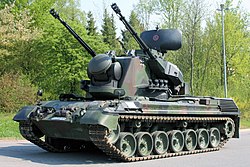

- Flugabwehrkanonenpanzer Gepard 1 A2 (self-propelled anti air gun), will be formally phased out in late 2010 and then replaced by SysFla in the upcoming years.
- LeFlaSys (light anti-aircraft missile system), based on Wiesel 2
- MANTIS (stationary counter rocket, artillery, and mortar system for base protection), to be delivered in 2011
- SysFla (system air defence - mobile and stationary platforms using the LFK NG and MANTIS), under development
- LÜR (radar system), being phased out


Engineer equipment
- Dachs (tracked engineer tank)
- Büffel (tracked salvage tank)
- Biber (bridge layer)
- Panzerschnellbrücke 2 (bridge layer), replacing the Biber
- Skorpion (mine layer)
- Keiler (mine breaker)
- M3 Amphibious Rig (amphibious vehicle)
- Motorboot 3 (motorboat)
- Medium Girder Bridge (bridge system)
- Faltfestbrücke (solid bridge system)
- Faltschwimmbrücke (swimming bridge system)
- Pontoon bridge
- Faltstraßensystem (mobile roadway system)
Aircraft inventory








The German Army operates more than 320 helicopters. Nearly all were built in Germany while nearly 40% are indigenous designs. 80 Eurocopter Tiger and 80 NH90 helicopters have been ordered.
| Aircraft | Origin | Type | Versions | In service[7] | Notes | |
|---|---|---|---|---|---|---|
| Attack Helicopter | ||||||
| Eurocopter Tiger | attack helicopter | 5 | 80 (planned), entered service | |||
| Transport/Utility Helicopter | ||||||
| UH-1 Iroquois | utility helicopter | UH-1D | 82 | being withdrawn; built by Dornier | ||
| Bölkow Bo 105 | utility/attack helicopter | 105P | 104 | |||
| Eurocopter EC 135 | utility helicopter | EC135 | 15 | |||
| NHI NH90 | transport helicopter | NH90 TTH | 3 | 80 (planned) | ||
| Sikorsky CH-53 Sea Stallion | transport helicopter | CH-53G/CH-53GS | 101 | 110 built by VFW | ||
Logistic equipment
- SLT 50-3 Elefant (heavy tractor trailer, tank transporter)
- Berge- und Kranfahrzeug, BKF 30.40 (salvage vehicle)
Non-combat vehicles
- Mercedes-Benz 250 GD "Wolf"
- KTM LC4 Military 27 PS, motorcycle
- ATV Yamaha Kodiak 400, Quad
- LKW 2t mil gl, 4x4 (Unimog)
- LKW 5t mil gl, 4x4
- LKW 5t tmil, 4x4
- LKW 7t mil gl, 6x6
- LKW 7t tmil, 6x6
- LKW 10t mil gl, 8x8
- LKW 15t mil gl, 8x8
- LKW 15t mil gl MULTI, 8x8
- Volkswagen T platform (T3/T4)
- Snowmobile Ski-Doo
Further reading
- Hubatscheck, Gerhard (2006), 50 Jahre Heer. Der Soldat und seine Ausrüstung, Sulzvach: Report-Verlag, ISBN 3-9323-8521-7
- Wheeler-Bennet, Sir John (2005), The Nemesis of Power: German Army in Politics, 1918-1945 (2nd ed.), New York: Palgrave Macmillan Publishing Company, ISBN 1-40391-8120
See also
- Bundeswehr
- Tank Battalions of the German Army 1956 - 2008
- Infantryman of the Future
- History of Germany during World War II
- Prussian Army
- Reichswehr
References
- ^ http://www.bundeswehr.de/portal/a/bwde/kcxml/04_Sj9SPykssy0xPLMnMz0vM0Y_QjzKLd443cTQCSYGYxgEh-pEwsaCUVH1fj_zcVH1v_QD9gtyIckdHRUUATi3qcg!!/delta/base64xml/L3dJdyEvd0ZNQUFzQUMvNElVRS82X0NfNENM
- ^ Reich is commonly translated as "empire," but this can be misleading; its actual connotation is closer to "realm," as in Frankreich, France, "realm of the Franks," or Österreich, Austria, "eastern realm."
- ^ See Jorg Schonbohm, 'Two Armies and One Fatherland,' Berghahn Books, Providence & Oxford, 1996
- ^ Official website of the German Armed Forces
- ^ "Die Streitkräftebasis" (pdf). Retrieved 2008-02-26.
- ^ http://www.marineforum.info/HEFT_5-2009/Camcopter/camcopter.html
- ^ Aviation Week & Space Technology 2009, . (2009): n. pag. Web. 13 Sep 2009. <http://www.aviationweek.com/aw/sourcebook/content.jsp?channelName=pro&story=xml/sourcebook_xml/2009/01/26/AW_01_26_2009_p0240-112924-59.xml&headline=World%20Military%20Aircraft%20Inventory%20-%20Germany>.
External links
Historical links
- German Armed Forces 1918-1945
- German Army pre 1914
- German Army 1914-1918
- German Army Organization 1914
- German Infantry Photographs from World War II - Colour photographs of German infantry during World War II
- Gebirgsjaeger - German Mountain Troops
- Axis History - Axis History site including German troops.


















